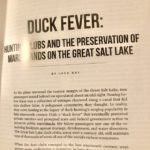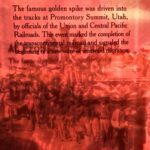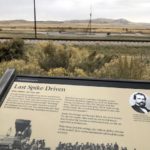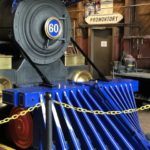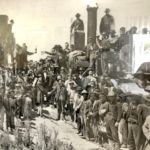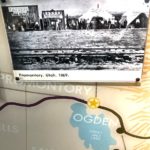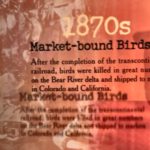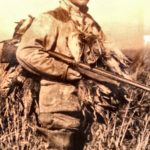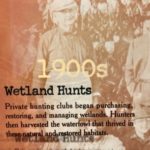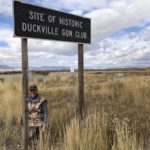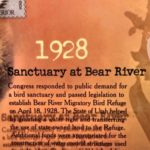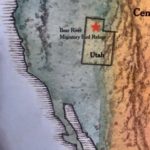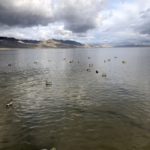Jack Ray is President of Utah Waterfowl Association, an avid hunter, conservationist and local historian. He colorfully describes a mostly unknown facet of American waterfowling history – Utah’s Great Basin. At the height of US market hunting, when passenger pigeons eclipsed the sun and divers carpeted Chesapeake Bay, why was Utah revered as the world’s best duck hunting? What historical events literally transformed duck hunting as we know it today? How important is this crown jewel to North America and what measures have been taken to preserve historical and biological values? Riveting episode.
Related Links:
Jack Ray Discusses “Duck Fever,” Market Hunting, Duck Club Origins, and Conservation of Utah Great Salt Lake Wetland Habitat
It’s hard to overstate just how important duck hunting was in Utah a hundred years ago. It was called the national sport of the state. And it was said that you could stand on a building in Salt Lake City and look out across the valley to the west, towards the lake, and there would be so many campfires of duck hunters out in the marshes surrounding the Great Salt Lake, that it would look like a prairie fire approaching.
Ramsey Russell: This is Ramsey Russell, GetDucks, where it’s Duck Season Somewhere. And today is the end cap of a five-episode series about Utah’s Great Basin, about the Great Salt Lakes, and if I said the words “market hunting,” what would you think? Chesapeake Bay? Sunken Lands, Arkansas? While I was there, I kicked off my whole trip with a very exclusive private hunting camp back on the north end. And one of the members had presented me with a story, a historical reference for this region, and it made my head explode. The author of that article is a local historian named Jack Ray who is our guest today. He wrote an incredible story called “Duck Fever.” From my understanding, he may be working on a book about this rich and colorful history, north of Salt Lake City. Jack, how are you today?
Jack Ray: I’m doing fine. It’s good to be here.
Ramsey Russell: Yes, sir. And I know that you duck hunt because I’ve called you a few times that you were in a blind duck hunting at Rudy Duck Club. I hate to do that. I hate when people call me, and I’m in a duck blind because that’s when the ducks are really going to start to fly. But Jack, just so people can kind of understand who you are, how long have you duck hunted?
Jack Ray: You know, I’ve duck hunted since I was twelve or thirteen years old. Did not come from a duck hunting or a hunting family at all. But when we moved to Utah, when I was about ten or twelve years old, we lived close to people who were into duck hunting, and it was very popular. And so my friends and some of the men in the neighborhood would take me out, and I got hooked on it then.
Ramsey Russell: It shocks people to know that I did not really come from a duck hunting family. My grandfather duck hunted, and he was in the stages of retirement from the sport of duck hunting when I came along and started getting into it. My dad didn’t duck hunt at. And I just fell into it in high school or just after high school with some friends and different people that thankfully introduced me to the sport. But you know Jack, one thing that struck me is, as I was out there hunting that area, that Great Basin, it was amazing because I’m sandwiched in between the Wasatch and Promontory Mountains, and I haven’t said that word right yet, I know. But you look one way and see one mountain range, look the other, there’s all this water in between, and it was amazing to me that anywhere I was standing, I could just look straight across that marsh twelve to fifteen miles, and that’s where I had hunted a day or two before, and then a dozen miles north across marsh, and that’s where I’d hunted. But every little niche, nook and cranny had all these different little micro niches and different species that we could hunt in that area. But what is your favorite duck species to hunt today? What do you like to target when you go out and hunt?
Jack Ray: My favorite species is the pintail. I just love them. I love the way they work. I love seeing them in the air. I love eating them. I think they’re the best tasting duck out there, and I think they’re just a beautiful, elegant bird. But frankly, in terms of what duck is my favorite, it’s whatever duck is flying best that day.
Ramsey Russell: Next one over the decoys. I love that.
Jack Ray: Yeah, that’s right. That’s about what it is.
Duck Hunting Utah During the 1800s
When those flocks of millions of ducks would get up in the air, off of the Bear River Bay, Utah, it would be like the sound of thunder. In the late 1800s, they couldn’t come up with descriptions colorful enough to fit what they were seeing. these are people who would have seen flocks of passenger pigeons. They would have seen the concentrations of waterfowl in the Midwest before the Kankakee Marsh was drained. Chesapeake Bay, all of those places. And yet they came here, and they talked about when the ducks would rise up off the Great Salt Lake, it would sound like six freight trains coming down the tracks, even when they were a mile away from the birds. They were just overwhelmed. And you can see this sense of awe and sense of wonder in their accounts.
Ramsey Russell: Jack, as you heard me say in the intro, when I read your article, “Duck Fever,” it opened up a whole new world and a whole new perspective of your backyard that I was just completely unaware of. I had no idea whatsoever, none. And I read it a few times so that I could grasp everything that you covered in there. What must it have been like to hunt that region back in the mid to late 1800s before the railroad had moved in?
Jack Ray: You know, a lot of people when they think of the Great Salt Lake, they think of a dead sea, because they know it’s really salty, and there’s no fish in it. And so they think, there must not be much wildlife there, and nothing could be further from the truth. And so when you read the accounts of what it was like, when people would go out there, and even in the earlier 1800s, when explorers would go out, when trappers would go out, and these are people who were accustomed to seeing huge concentrations of wildlife throughout the nation. But when they would see the Great Salt Lake, and specifically Bear River Bay, which is where you were, they had almost identical descriptions. And that is, that they were just amazed. And when these flocks of millions of ducks would get up in the air, off of the Bear River Bay, it would be like the sound of thunder. And that continued even into the late 1800s and early 1900s, and to a somewhat diminished extent, continues today. That these people who would go out in the late 1800s, they couldn’t come up with descriptions colorful enough to fit what they were seeing at Bear River Bay. They called it the “Valhalla of Waterfowl,” “Elysium for Ducks,” the “Paradise of Duck-dom”. Just one name after another. Trying to give some description to what they were seeing in front of them. It was like there were ducks everywhere. It was amazing.
Ramsey Russell: That really says a lot. That really says a lot because we’re talking about the mid to late 1800s before westward expansion, before all this mass civilization. And there was still everything, the whole continent was practically the same as it had been when it was discovered, let alone out west. So they had a basis of comparison. It wasn’t just as compared to the South Delta of Mississippi today. It was compared to then, to Sunken Lands or Chesapeake Bay or to parts of Europe. That’s what’s so astounding.
Jack Ray: Yeah, exactly. So these are people who would have seen flocks of passenger pigeons. They would have seen the concentrations of waterfowl in the Midwest before the Kankakee-or how ever that’s pronounced-that marsh was drained. Chesapeake Bay, all of those places. And yet they came here, and they talked about when the ducks would rise up off the Great Salt Lake, it would sound like six freight trains coming down the tracks, even when they were a mile away from the birds. So they were just overwhelmed. And you can see this sense of awe and sense of wonder in the accounts of people who you think at that time, may not have been so into nature, or so easily impressed. Kind of a little bit jaded maybe. And yet, here, it was a total sense of astonishment.
How many Duck Did Utah Market Duck Hunter Vince Davis Shoot?
Ramsey Russell: Yeah, that’s incredible. And some of the numbers from the market hunters, I know Vince Davis purportedly shot a whole lot of ducks during a fifty-day period. What was that number, 4,020 some odd ducks he shot in a fifty-day period hunting out there? Mind-numbing.
Jack Ray: Yeah, in one five-day period. And you need to remember, he didn’t hunt on Sunday. In a five-day period, he shot over a thousand ducks. And in the first five weeks of the season one year, he shot 4,100 ducks. Another fifty-day period a few years later, he shot 4,200 ducks. We’ll get into a little bit more about him. But he was a guy who was just a prodigious market hunter at the time and then who became kind of a promoter of the recreational aspects of the Great Salt Lake and started promoting it, marketing it to water fowlers throughout the country. When people started hearing the report, it didn’t take long for people from around the country to start making their way to Great Salt Lake and the word to get out.
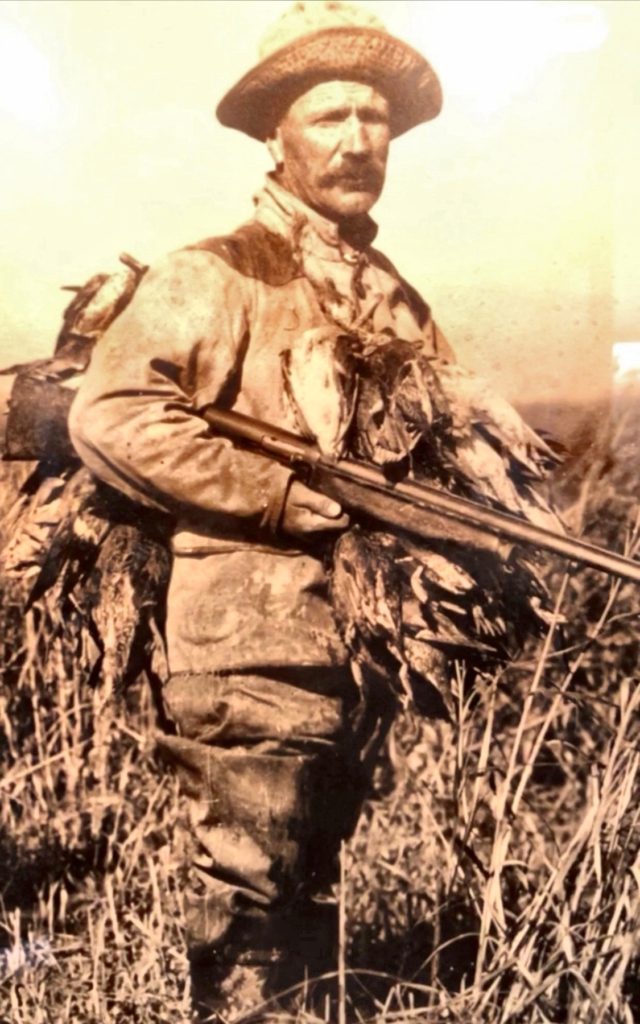
Historical Duck Hunting Techniques in Utah’s Bear River Bay
A couple of miles out there, if the wind shifts and blows the water out, it could bring tears to your eyes. These guys would be out there now having to push their boat out across the mud flat, and if they were guiding somebody, they’d have to push the person they were guiding, as well as a hundred big ducks they shot and everything else.
Each stroke of the oars would create a little divot of mud. And as he was looking back across this line of divots, he could see flocks of teal swirling around, and diving on, and then landing among these divots of mud. Instead of worrying about decoys or anything else, he would just take a shovel up. And when they would set up the blind or set up where they were going to hunt, they would just turn over spade folds of mud in the little water, so that they would have a few dozen spade folds of mud surrounding the blind, and the ducks would come into these spade folds of mud.
Ramsey Russell: One thing that interested me, and I thought about this a lot as I was out there hunting with mud motors and airboats, is how those people back then accessed that vast region? How they got from hard ground to back where the ducks may have been, the teal or the canvasback or whatever they were targeting? And then, what they used as decoys, I’ve never heard of that before. But how do you describe how they would have- They couldn’t walk, well, I guess they could walk some areas, but they couldn’t walk all areas, out across that mud that was sunk with a lot of silt. How do you remember them getting there, and some of the techniques they used to lure the birds within range?
Jack Ray: Yeah. So the way they would do it, particularly along the shore of the lake and then up in Bear River Bay- I think what people need to understand is, the Great Salt Lake is very shallow, and so the areas they would hunt would be two, three inches deep. And so initially they would use these wooden boats they had built especially for the purpose, and it might almost be better to call them sleds that would also float and work on the water. They would push them across the mud, and when you get up in those parts of the Great Salt Lake, if the wind shifts, it can push the water out. So what little flotation you might have gotten when you were on your way out to go hunting, a couple of miles out there, if the wind shifts and blows the water out, it could bring tears to your eyes. These guys would be out there now having to push their boat out across the mud flat, and if they were guiding somebody, they’d have to push the person they were guiding, as well as a hundred big ducks they shot and everything else. But as the story goes, one day, Vince Davis was making his way across one of these very shallow areas, and he was using oars to propel the boat, and so as he would oar the boat across, each stroke of the oars would create a little divot of mud. And as he was looking back across this line of divots, he could see flocks of teal swirling around, and diving on, and then landing among these divots of mud. Instead of worrying about decoys or anything else, he would just take a shovel up. And when they would set up the blind or set up where they were going to hunt, they would just turn over spade folds of mud in the little water, so that they would have a few dozen spade folds of mud surrounding the blind, and the ducks would come into these spade folds of mud. When you think about it, that’s not too different from the silhouette decoys that people use out on the Great Salt Lake today. I suspect birds from a hundred yards away can’t tell those silhouettes are really in the shape of a duck. They’re more forms and massive objects out on the water, and they associate that with the concentration of ducks, and so they come in.
Ramsey Russell: There’s a lot of truth to that. It was described to me, there was actually a technique that I’ve never seen or heard of, that they use at times of the year today, where they go out and put that little sled in very, very shallow water, and then surround themselves with silhouettes that are pitch black. It’s the same thing, isn’t it?
Jack Ray: It’s the same concept that still works with the green-winged teal, and it still can be very effective. And as they would shoot ducks, they would take the ducks, and they would put a duck on top of each of these mounds of mud to make them look a little bit more realistic. So that’s how they would hunt. If you’ve ever held an old wooden decoy, those things are heavy. Each decoy weighs several pounds. And when you’re in this very shallow water in the thick mud, you really don’t want to be carrying around another thirty or forty pounds of decoys in your boat. You want things to be as light as possible.
How Railroads Changed America Duck Hunting
It was right there, not too far from the Bear River Bay that Union Pacific and the Central Pacific railroads collided. And as I understand it, that really had a significant impact on how a man like Vince Davis, and the formation of some of these old clubs came to be. It just made that part of the world very accessible all of a sudden. And it opened up all of the markets in the East to waterfowl from the Great Salt Lake.
Ramsey Russell: I’m all about that. I guarantee you. You know what, it’s funny, all this time I’ve watched the History Channel, and I understand the economic significance of the Union Pacific and the Central Pacific railroads. One from New York, one from out West, colliding in the Midwest, and what it did for American infrastructure and American economy, but I never really thought about how it must have impacted duck hunting. What I gathered while out in Utah was- First of all I guess I just didn’t pay close enough attention to realize that they joined in Utah. I was thinking more along the middle of the United States if somebody had asked, but it was right there, not too far from the Bear River Bay that those two railroads collided. And as I understand it, that really had a significant impact on how a man like Vince Davis, and the formation of some of these old clubs came to be. It just made that part of the world very accessible all of a sudden.
Jack Ray: Yeah, it did. As you mentioned, the two rail lines came together, almost just a stone’s throw from the north shore of the Great Salt Lake. And what that did is it opened up all of the markets in the East to waterfowl from the Great Salt Lake. So you have this huge concentration of waterfowl, just literally a couple of miles from the rail line, and people could go out and shoot these ducks and send them back East.
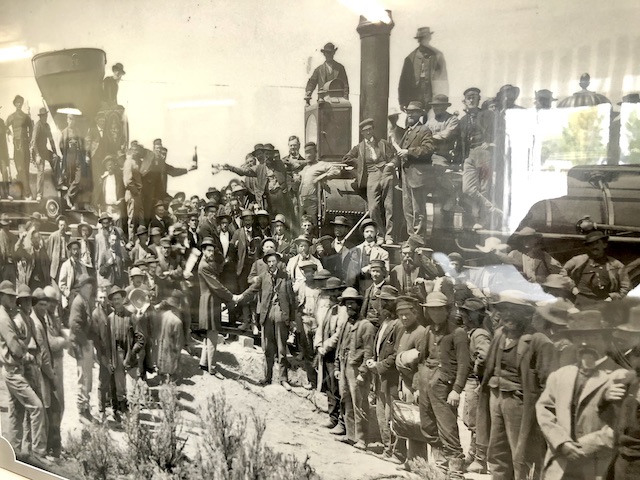
Waterfowl Market Hunting in Utah
Back then, the duck that fetched the highest price on the market would be canvasbacks from the Chesapeake Bay back on the East coast, and they would get several times the price of big ducks anywhere else. So, some enterprising folks on the north end of the Great Salt Lake named their duck camp, The Chesapeake Bay Duck Club, so that they could stamp on the box, “Ducks Chesapeake Bay,” and they could get the Chesapeake Bay premium.
Jack Ray: Before that, there had been market hunting. But it was primarily for the local markets. People in Utah really valued waterfowl as a delicacy. In fact, they noted that when ducks would start hitting the market in Salt Lake City, the market for chickens would dry up because people preferred to use wild duck to chicken. And you know, they would talk about the ducks being “fat as little pigs.” People just loved to eat waterfowl. I think people have kind of forgotten how to cook duck in modern times. I think a little bit of that is coming back now, but you hear the old jokes about cooking duck on a board, and then throwing the duck away and eating the board and everything. That would have been really shocking to the ears of people back in the 1900s, and I think to those today who know how to cook ducks, it’s also shocking. They loved to eat ducks, and so they got a lot of ducks on the market and started sending ducks around the country.
And Utah became concerned pretty early on that too many ducks were being shipped out of the state and that it would have really a negative impact on the waterfowl populations on the Great Salt Lake. So by 1900, Utah had banned the export of ducks. They allowed them still to be sold within the state, but not out of the state. So, ducks would be shipped surreptitiously I guess. They’d be shipped under false pretenses in crates marked butter or other products out of state. It’s kind of interesting. Back then, the duck that fetched the highest price on the market would be canvasbacks from the Chesapeake Bay back on the East coast, and they would get several times the price of big ducks anywhere else. So, some enterprising folks on the north end of the Great Salt Lake named their duck camp, The Chesapeake Bay Duck Club, so that they could stamp on the box, “Ducks Chesapeake Bay,” and they could get the Chesapeake Bay premium.
Ramsey Russell: That camp is still in existence, is it not?
Jack Ray: Yes, it is. It exists today. They dropped the word “bay” from their name, but it’s still The Chesapeake Duck Club. And it’s one of the better duck clubs on the lake. And you know, there are a lot of duck clubs, but that’s certainly one of the finest.
Utah Duck Hunting Clubs Origins
Ramsey Russell: Well that brings up a very good point. I was astounded to learn just how many duck camps there were. More than one or two or three that have existed for well over a hundred years in the region. Can you describe that? How many clubs there might be or?
Jack Ray: So back around 1890. In fact, this was Vincent Davis again. He was a farmer, he homesteaded some of the sort of semi-barren land out by the mouth of the Bear River and decided, instead of just strictly market hunting himself, he would also open a duck camp because he noticed that people were wanting to come out there duck hunting. And he developed this duck camp on his property out there, where people would pay to come out and hunt ducks with him. And that was in 1890, and people saw the success of that. Duck camps started popping up around the Great Salt Lake, and there were other ones on the north shore and on the south shore. They mostly catered to local residents and would charge a daily fee for people to hunt their property or different things. But as time went on, of course, there were people who wanted to have some exclusive access to property. And so they started forming duck clubs. And the first duck club would have been in the 1890s, on the south shore of the Great Salt Lake down by Salt Lake City. And that would have been the New State Duck Club, which is still in existence today and still very vibrant, over 3000 acres in size. And they’ve been very tenacious in terms of preserving themselves, as have many of the duck clubs. But most of the duck clubs that exist today are a hundred years or more old.
Ramsey Russell: That to me is utterly incredible. And what I came to realize when I was out there is the role in conservation those men became. All we hunters preach conservation. Hunters are conservationists because of the excise tax we pay, the Pittman-Robertson Act, or the duck stamps we buy, and all this stuff. But man, this wasn’t just citizens and politicians from Salt Lake City. They were coming from all over the United States, if not the world, to own a stake in some of this incredible Utah duck hunting. And today, a lot of the property that has not been developed or been dried up, but that is still under very active management, belongs to these private clubs. Is that correct?
Role of Utah Duck Clubs in Waterfowl Habitat Conservation
Utah duck clubs today encompass somewhere around 40,000 acres of habitat around the Great Salt Lake. And today, the wetland habitat pretty much ends at the gates of the duck clubs. These Utah duck clubs have held fast. They’ve resisted temptation to sell out. They have resisted pressure trying to push them away. They’ve resisted drainage schemes of one type or another, water grabs, you name it, and they have hung on.
Jack Ray: Yeah. Utah duck clubs today encompass somewhere around 40,000 acres of habitat around the Great Salt Lake. And today, the wetland habitat pretty much ends at the gates of the duck clubs. And there are a couple of nature preserves, and of course there’s some state waterfowl management areas that we’ll get into, maybe later. But all of the other wetlands that existed that weren’t preserved by duck clubs, basically today, they’re under refineries, they’re under industrial complexes, they’re under roads or one thing or another. And it’s really those duck hunters back in the late 1800s and early 1900s, who managed to save a huge chunk of the Great Salt Lake ecosystem. It’s hard to overstate just how important duck hunting was in Utah a hundred years ago. It was called the national sport of the state. And it was said that you could stand on a building in Salt Lake City and look out across the valley to the west, towards the lake, and there would be so many campfires of duck hunters out in the marshes surrounding the Great Salt Lake, that it would look like a prairie fire approaching.
Ramsey Russell: Wow.
Jack Ray: Just extending for miles and miles, and most of those natural wetlands have been lost, and the wetlands that remain are wetlands that were either natural, or that were created by the duck clubs, and they have persisted in the face of all of the development that has occurred. You got to realize that 80% of the state’s population exists basically surrounding the Great Salt Lake and extending down to another big lake. Those are the people who are consuming water, those are the people who need roads to drive on, who are building buildings, who are building one thing or another. And so there has been just massive pressure placed on the Great Salt Lake ecosystem and the Great Salt Lake marshlands over the past century. And in the face of all of that, these duck clubs have held fast. They’ve resisted temptation to sell out. They have resisted pressure trying to push them away. They’ve resisted drainage schemes of one type or another, water grabs, you name it, and they have hung on.
Inception of Public Land Duck Hunting in Utah
As some of these investors started buying land for their private use, there became an uproar because there were a lot of hunters on a decreased base. But the state responded by adding more land to accommodate more people for the tradition of duck hunting.
Jack Ray: They also happened to trigger- Because they were tying up land for their hunting, people who didn’t belong to a duck club complained and said, “Well, hey, they’re cutting us off from these hunting areas.” And so that pushed the state then to set aside tens of thousands of acres of additional habitat around the Great Salt Lake, so that we now have a string of state waterfowl management areas that extend literally from the south shore of the lake to the north shore of the lake. And that started back in the 1910s and 1920s that the state started the process of doing that at a time when most other states thought the only good marsh was a drained marsh.
That’s what you do with marshes. You drain them, and you turn them into something else. And in Utah, at that same time, they were setting aside- Well, the first one was called the public shooting grounds. I guess that wouldn’t be a politically correct name for a refuge today. But that was what they did it for. They did it because of duck hunting. So you have the second driest state in the nation with all of its development concentrated in the same place as the marshes, in a very conservative state. And yet they set aside all of this land and all of this water. And it isn’t just because they thought it would be neat for ducks to have plenty of fresh water to drink. They did it because they wanted these areas to be preserved so that people would have a place to go and experience the marsh as a duck hunter. Because a lot of them were duck hunters, and they had been out there and maybe they didn’t get misty eyed every time the sun set over the marsh. But they knew what it was like to be out there, and they knew what it was like to see that. And they understood that it was an important thing in Utah’s culture and heritage, and so they preserved it.
Ramsey Russell: One thing I gathered from listening to you, and reading that “Duck Fever” article, and gaining this context is, today, if you get on the chat rooms and get into the social media, it’s a prevailing thought that we have too many hunters on not enough land. It was a slap in my face. Just wham. It woke me up like, wait a minute. This isn’t a modern day issue. This has existed since the 19th century because just as you described, back in those days, as some of these investors started buying land for their private use, there became an uproar because there were a lot of hunters on a decreased base. But the state responded by adding more land to accommodate more people for the tradition of duck hunting. But still, I marveled that there were a lot of hunters stacked in at times, to a relatively small piece of property. And that’s what struck me, that this is not a modern-day dilemma. And duck clubs existed for as long as, I guess, duck hunting has. As a recreational sport. Because around the same time, that’s what this story is kind of alluding to, around the same time that the two rail lines met, there was a transition nationwide, if not worldwide, but certainly in the Utah area, from market hunting to mass recreational duck hunting. And almost immediately, there were people that felt disenfranchised, that didn’t have an opportunity to hunt, couldn’t afford to hunt, or didn’t want to spend the money on a piece of property, that all of a sudden needed somewhere to hunt. So for as long as recreational duck hunting has existed, there has been people grinding the axe about not having somewhere to duck hunt. And that’s what struck me. They say history repeats itself, and that’s just what struck me is this narrative of the history of Utah duck hunting unfolded. Going back to Vince Davis, we drove by from the north end one day. We drove by a sign that is now in National Wildlife Refuge called Duckville. What was Duckville at the time?
Duckville, the Original Utah Duck Hunting Camp
Jack Ray: So Duckville was a name that Vince Davis gave to his original duck camp. And so Vince Davis was sometimes called the Duke of Duckville. But Duckville was the name he gave to his camp. And then, when people started coming out, eventually industrialists from Denver and back East got interested in acquiring some of this land. So they purchased his land, and he had two locations of this duck camp, and one became the Bear River Club that still exists today. And the other one was Duckville. And Duckville continued on as a club until there were floods on the Great Salt Lake. They kind of raised the level of the lake, the lake froze, and then basically the shifting ice leveled everything out there. But they really were a fascinating club. They kind of catered to both Salt Lake City folks as well as to a number of actors from Hollywood and different things who would hunt there. Andy Devine and Wallace Beery, I think was another one. They had that clientele and interestingly, this is a little aside.
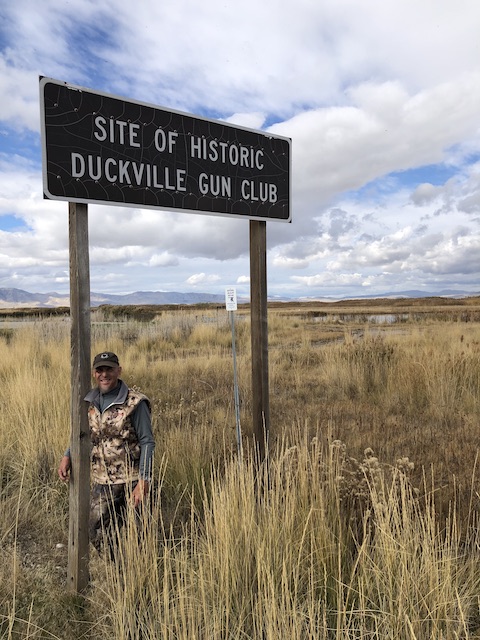
A lot of these duck clubs would have full-time caretakers and families that would live out in the marsh, and they would power the place- the lights and the stove and everything- with gas that they would take out of the marsh. So they would drill down for water, and the water would have a lot of gas mixed in with it, and they would separate the water and the gas. And they’d use the gas to power lamps and stoves and different things like that. Just kind of an interesting aside. What you had said earlier about the disputes between different groups of duck hunters is really something that has continued on. I mean, the more things change, the more they remain the same I guess. When the clubs initially started acquiring land, that resulted in a number of lawsuits, brought in order to establish the right of the duck clubs to control access to the waters on their property.
And so they started establishing public shooting grounds essentially. And again, 80% of the state’s population is within thirty minutes of a state managed waterfowl management area, where during the season, you can go out seven days a week. You don’t have to draw for a blind. You don’t have to worry about any of that stuff. You can just go out and go duck hunting.
Ramsey Russell: Water rights?
Jack Ray: Well, not just water rights, but actually access to the waters. And so people said, because it was wet, they had a right as a member of the public to go on it essentially, and the courts uniformly upheld the right of the clubs to control access to the waters on their property. And so that resolved that. And because those court decisions were resolved that way, that left the Legislature then with the choice and the directive, essentially the decision, that we’re going to start establishing these public hunting areas. And so they started establishing public shooting grounds essentially. And again, 80% of the state’s population is within thirty minutes of a state managed waterfowl management area, where during the season, you can go out seven days a week. You don’t have to draw for a blind. You don’t have to worry about any of that stuff. You can just go out and go duck hunting. And that’s a tremendous legacy that we in our era have, that was gifted to us, basically, because of the fervor of all of these duck hunters back in the early part of the 20th century.
Ramsey Russell: And it truly is. I will say this, I’ve not hunted everywhere in the United States, but I’ve hunted a lot of places, and I cut my teeth on public land in the Deep South. That’s where I learned to duck hunt. And it was astounding, the public land opportunities in Utah. And depending on how well equipped you were to get further from the boat ramp, it amazed me that we four or five guys could jump in an airboat, trek off and get somewhere, knowing there were fifteen or twenty boats at the boat ramp when we left or fifteen vehicles there. So there were a lot of hunting parties there, yet we didn’t hear a single gunshot while we were hunting. That’s a vast area that’s available for public. I really can’t think of anywhere else that has that kind of opportunity for public land hunters in the United States. If it is, I’m completely unaware of it. I really was impressed. It’s very, very impressive. And I know we met with Rich Hansen that manages Ogden Bay and several of those WMAs. Wow, I got the tour of Ogden Bay, and a lot of the Phragmites control he’s doing, and a lot of the habitat creation he’s doing. For example, the state of Utah has this clever program because duck bands are all that and more to some people. You can enter this duck slam contest for $20 as you shoot a mallard limit or a teal limit or a goose limit or a diver slam or something. You can be awarded a band. But what they do with those revenues, $20 per entry, they leverage for federal funding. And it ends up in Rich’s budget, and all of a sudden he’s showing me a quarter-section of former Phragmites, dry Phragmites that is now a lush productive wetland available for hunters. And it just astounded me how well managed some of these properties were and how accessible they were, and a lot of the amenities across those dikes or canals. They had little land bridges so that the public could access areas. I was absolutely blown away that there was that much public land hunting opportunity.
Read Article (PDF)
Duck Fever: Hunting Clubs and The Preservation of Marshland on the Great Salt Lake
Continuing Role of Duck Clubs in Utah Waterfowl Habitat Conservation
Ramsey Russell: But, Jack, excuse me. I know that as you were talking about the water access for some of these clubs, and it becoming involved legislatively- Can we talk about some of today’s issues? We talked about all the needs for water. I’ve heard that the population in the valley is going to double in the next twenty years, and it’s going to be more and more people. You’ve got industry, you’ve got humans, neighborhoods, you’ve got all these competing interests for water. But I know that you were involved somehow to protect some of the historic clubs from becoming developments. Can you expound on that subject?
Jack Ray: Yeah. So one of the hats I wear is I’m president of the Utah Waterfowl Association. And so we concluded when we created the Waterfowl Association, probably close to about fifteen years or so ago now, that there was a real need for duck hunters to engage in the legislative and policy making process. That role really was not being filled by any group. And the big decisions that would control the fate of the Great Salt Lake, and therefore the fate of duck hunting in Utah, would be happening at the state capital and in city councils and county commissions, and duck hunters needed to have a voice there. They needed to engage in that process. For too long, I think the water fowling community had just kind of kept its head down and crossed their fingers and hoped for the best. And with the growing population, and a population that’s going to be continuing to grow for decades to come, as you mentioned, with increasing demands on water and everything else, that need is more and more urgent. And so we got involved. And thankfully, Ducks Unlimited I think, thanks to the insight and efforts of Gary Link, who’s their Western region policy director, and another Western region officer Jeff McCurry, they have begun recently to play a significant role on the policy front here in Utah as well, because I think they recognize the critical need of it. But one of the things the Utah Waterfowl Association did is we were concerned that encroaching development was going to be placing increasing, and almost overwhelming pressure on the duck clubs because they exist where all of these people live. And so we drafted and presented to the legislature a bill that designates these duck clubs-and it could be a private nature preserve as well, like Audubon property or something like that-as migratory bird production areas. And they are given protections against nuisance complaints, they’re given protections against annexation, they’re protected against any county enacting any ordinance that would curtail their traditional waterfowl management and hunting activities. And so it provides them with the tools they need to survive going through this next century. And hopefully, we’ll see them survive another a hundred years.
I know when I have been engaged in discussions with legislators and others, or with developers, and they try to reassure me and say, “Don’t worry, that won’t happen for five or ten or fifteen years.” I have to tell them, “No, that’s not the time frame we’re looking at.” We’re looking out beyond the horizon. We have a legacy that extends back well over a hundred years, and we want that legacy to extend off into the future for as far as we can see, for children, for grandchildren, and for other people like me who didn’t come from a hunting family. They got addicted to the marsh because I would put on cheap, uninsulated rubber hip boots and trudge out into the marsh on Saturdays with my friends and get cold and get numb feet. And then the sun would go down, the sky would turn orange, and the water would turn orange, and the air would fill with ducks and whistling wings going past your head. And people need to have those experiences, and so we need to preserve this legacy. And that’s going to require getting involved. It’s going to require getting engaged in ways that I think duck hunters have not normally been used to getting involved. They’re used to doing banquets, and thank heavens, we do banquets and raise money and get people excited that way. I take my hat off to everyone who’s involved in those things. But we’ve got to also engage in the policy arena, and we’ve got to engage in the legislative arena, and we’ve got to stand up for ourselves and be willing to draw a line and say, “This far and no further.” And we’re going to fight, and that’s what we have to do.
Ramsey Russell: Jack. That brings us to a very good point. I would dare say that every person listening right now, whether they’re in the state of Utah or not, many are not. There’s a wetland, there’s a habitat to which their tradition and their children’s future is dependent. Who’s protecting it, I would ask. Who is protecting that? Who is championing the future of hunting in your backyard? I would ask anybody listening. You brought up a very good point, Jack. What would be your suggestions, as someone that has fought this battle legislatively, that has become involved at the level that you have in Utah? What would you suggest to a twenty-two year-old in Mississippi, or a thirty year old in Kansas, or someone in Maryland? What would you suggest of how beyond the raffle tickets, they could become involved in and have a meaningful voice in conservation today?
Jack Ray: I think one of the first things you need to do is you need to pay attention. So you need to pay attention when there’s a proposal that’s going to drain the marsh or that’s going to be bring development close to your marsh, or your duck club, or wherever it happens to be. And then you need to talk to people, and you get them organized, and I’m not talking about grabbing the pitchforks and the torches, storming the castle kind of thing.
Ramsey Russell: But in the era of social media, you can create visibility towards issues, and everybody has access to a telephone that they can call their congressmen, everybody.
Jack Ray: Exactly. Yeah. What I have started doing is I take legislators, I take city councilors and others, and I take them duck hunting, or I take them out into the marsh. Not all of them are interested in duck hunting. And for those who would just like to see it, I take them out there, and it is an illuminating experience for them. They get out into the marsh, and they see what is out there, and they see the bird life, and they see the beauty of the marsh. And it provides them with a perspective, and a sense of connection, and a sense of ownership that they did not have before they walked through the gates of that duck club or that marsh. A lot of times they’re taken places where they stand in the parking lot, and if somebody points to a seagull sitting on the water half a mile away and swatting mosquitoes or something like that, I get them in a boat. We put them in a boat, and I drive them out into the marsh, and they see birds swirling around their heads and rising up off the water. And I’ve taken bureaucrats from government out there, and sometimes it doesn’t mean they’re going to vote my way every time. It doesn’t mean they’re always going to see eye to eye with me, but it means they’re going to have a degree of sensitivity and appreciation that they didn’t have before, and that it’s more likely that they’re going to be taking those things into consideration as legislation is crafted, as policy decisions are made, planning decisions are made, and it has had a significant impact. I’ve had people come back after one of those things, who may not have cared much about the Great Salt Lake before, and it’s kind of aweing to them, and they just asked me, “Jack, what can we do to save this?”
Ramsey Russell: So that’s a very strong message. I look at it like children. As a daddy, I raised my kids to love the outdoors and to love hunting and stuff. But I’ve always thought of it like, people only know about the things that they actually touch, and they only care about the things that they know. So it starts with touching. If you’re going to get people, politicians, or nine hundred people, or anybody to truly care about something, you’ve got to let them touch it, you’ve got to immerse them into it, and expose them to it, and I know this may have been a little bit backwards describing the ecological significance of the Great Salt Lake, but when I think back to my experience in Utah for nearly ten days, it was such an amazing, almost indescribable experience because out there on the flats, running in a boat or an airboat, it was like surfing on glass. It’s like if I tried to video it, you can see the decoy bag flopping, and the dog’s ears flopping, but otherwise, it looked like you were motionless, just sitting motionless, surfing across silver. And at times in the sunrise with the cloud reflecting on the water, it really was one of those moments like Forrest Gump described, not knowing where heaven stopped and the earth began. We saw a lot of species of ducks, swans, geese, but a lot of those different shorebirds, we saw racing across those mudflats in an airboat going duck hunting was just like going across those mudflats down in Sonora, Mexico against the Sea of Cortez in February, same shorebirds, in fact. It was the same species, queuing into the same habitat type. Just shorebirds by the bazillions.
Importance of Great Salt Lake region to Migratory Waterfowl and Birds
There’s something like ten million birds a year that pass through the Great Salt Lake, including about seven million ducks. Well over half of the continental population of tundra swans passes through the Great Salt Lake, 40% of the continental population of your grebes. A quarter of the continental population of cinnamon teal breeds on the Great Salt Lake. If you lost the Great Salt Lake, there would be this tremendous vacuum, it would become a desert.
Ramsey Russell: Could you speak of why all these conservation things we’re talking about in the Great Salt Lake- Could you just expound on some of the factoids of the Great Salt Lake in terms of ducks and shorebirds and things of that nature?
Jack Ray: Yeah, the Great Salt Lake, I think is the largest natural water body in the continental United States, West of the Mississippi. If you were to think of British Columbia, Alberta and Saskatchewan having a funnel, the big end of the funnel stretching across those three provinces, and then it narrows down, the tip of that funnel is the Great Salt Lake. And most of those birds work along the eastern side of the Great Salt Lake, and they migrate. Some species migrate all the way to Argentina. And so there’s something like ten million birds a year that pass through the Great Salt Lake, including about seven million ducks. Well over half of the continental population of tundra swans passes through the Great Salt Lake, 40% of the continental population of your grebes. A quarter of the continental population of cinnamon teal breeds on the Great Salt Lake. You could just go through species after species. And if the Great Salt Lake went down, if it were dewatered, if it ceased to serve its role in the Western Hemisphere, because the marshes along the Great Salt Lake, the duck clubs along the Great Salt Lake, the refuges, lost their water or whatever the case may be, populations of birds throughout the western half of the continental US would be dramatically diminished. In fact, this was recognized as far back as the 1920s.
The whole reason that the Bear River Bird Refuge was created is because duck hunters throughout the Western United States were worried that if Bear River Bay went down, water fowling in the Western United States would collapse. And that may be a bit of an overstatement, but it’s not much of an overstatement when you consider several different bird species that we don’t hunt, like grebes and phalaropes, as well as other species. If you lost the Great Salt Lake, there would be this tremendous vacuum, it would become a desert. There wouldn’t be any place for these birds to go and to feed. And some of these species will double their body weight on the Great Salt Lake before they’re continuing their migration to Central and South America. So you really can’t overstate the importance. And because these saline lakes or terminal lakes are at the end of the pipe, they’re the last ones to get the water. And if that water is sucked up for other uses, which may be good uses, but if nothing is left over for these lakes, they dry up. You look at what happened to the Aral Sea in the former Soviet Union and other saline lakes around the world. And they become just these dust bowls that create health hazards for the people in the surrounding areas and the whole natural system is lost. And so, I heard a refuge manager once say about the Great Salt Lake, and I really don’t believe it’s an overstatement as I’ve looked at it, I think it’s completely accurate. He said, “You know, The Great Salt Lake is just as large and probably more ecologically important than the Florida, Everglades.” And people probably haven’t heard that. But if you look at the bird numbers and the bird species that depend on the Great Salt Lake, you could make that argument pretty convincingly.
Ramsey Russell: Yes, you could. And the people and the hunters that are dependent on it. That’s profound. But Jack, thank you so much for your time and for sharing your knowledge of the history of this region. I find the topic fascinating.
Jack Ray: Well, thank you for the opportunity to talk. Thank you.
Ramsey Russell: And folks listening, hunters are conservationists, that’s the drive home point. We hunters are conservationists. Yeah, we go out and shoot ducks, but it’s to benefit the wildlife and society at large. Thank you all for listening to this podcast. @RamseyRussellGetDucks on Instagram, all of these stories we go a little bit further in depth. Please take a look, and I’ll see y’all next time.




